https://www.youtube.com/watch?v=h9tTqrW1WMc
How To Cook A Perfect Steak At Home _ Bon Appétit
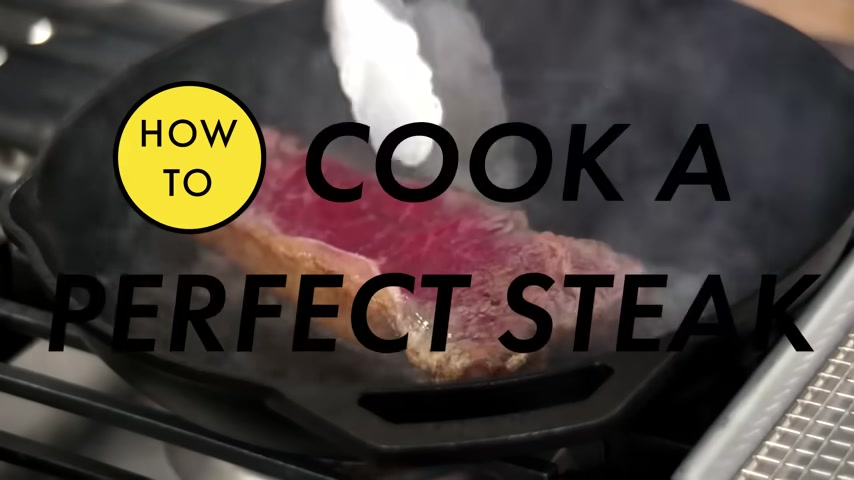
You see , you get that deeply caramelized crust all over the stick and then that perfect medium American Center .
I'm gonna show you how to make my version of the perfect stick .
My perfect steak happens on the stovetop in a really hot pan .
No kind of fancy gadgets , no cry , no seasoning and days in advance .
It's something that you all can do at home after you see this .
So the key to this uh method is choosing the right cut of meat .
There's something about the New York strip where it's well marbled , but it doesn't have a tremendous amount of fat like the rib eye .
Uh It also it's better portion size and I like the texture of it more .
So first thing I just want to pat the steak dry because water really is the enemy when it comes to getting a good caramelization .
Not only will it not get that kind of sear that we want , but mixing that water with the oil , it's gonna likely splatter .
Now I'm gonna let it rain with salt .
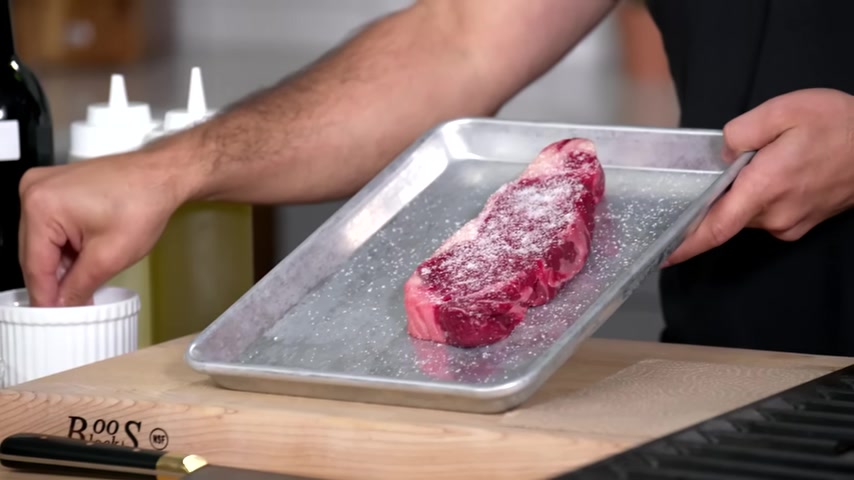
I prefer to use diamond crystal kosher salt just so I can see how much salt it really sits on the surface .
That gives you a good sense .
I want that salt so you can actually taste everything .
Salt is really the only thing that a cut of meat will absorb spices and pepper .
It's always gonna sit on the surface salt .
On the other hand , will actually properly absorb .
I'm going to do something that most people don't do .
And I'm just gonna lightly score this very lightly piercing the fat just allows it to quickly render a little bit faster .
I'm gonna let this chill in the fridge .
You wanna at least let it sit until you don't see any more salt on top .
You can see how it's already starting to dissolve .
I keep it uncovered so that the steak can dry out , preferably even on a wire rack , which I see right there , which now I'm thinking of using .
We're going in here .
Mhm .
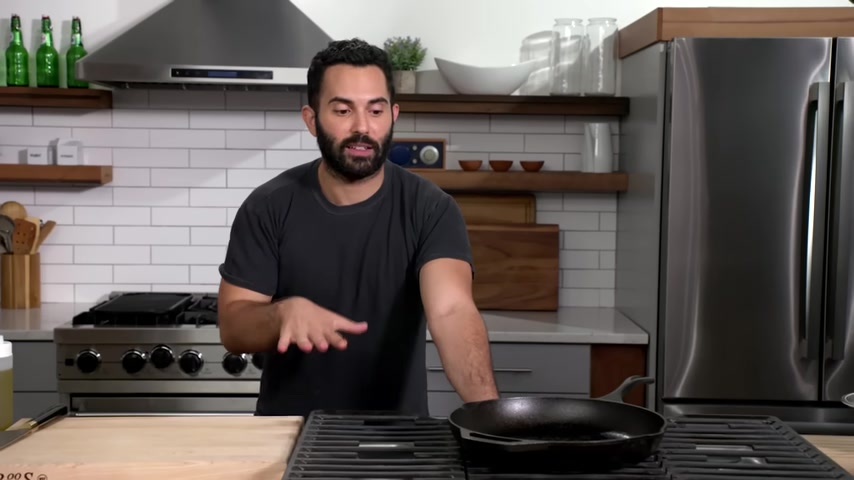
My reason for going with a cast iron , it just reacts to eat so quickly and it gets hot faster than most other pans .
A black still also will do that .
You also have the entire surface of the meat having direct contact to the surface of the pan unlike a grill where it's only touching the grates .
I would not uh go with a non stick because I'm just never gonna get that kind of bark like deep crust that I'm going for .
We have our steak ready .
I'm going on medium high heat .
It's quite hot .
You see how it's smoking .
That's great .
I wanna rub a little bit of oil on the steak directly .
Not in the pan .
The reason why I'm using neutral oil versus , let's say an olive oil or a butter , butter has , um , the milk solids which will burn , uh , olive oil .
Uh , you don't really need that flavor in here in the steak .
Uh , also I wanna get a hard sear and I think it's better to do that with a neutral oil .
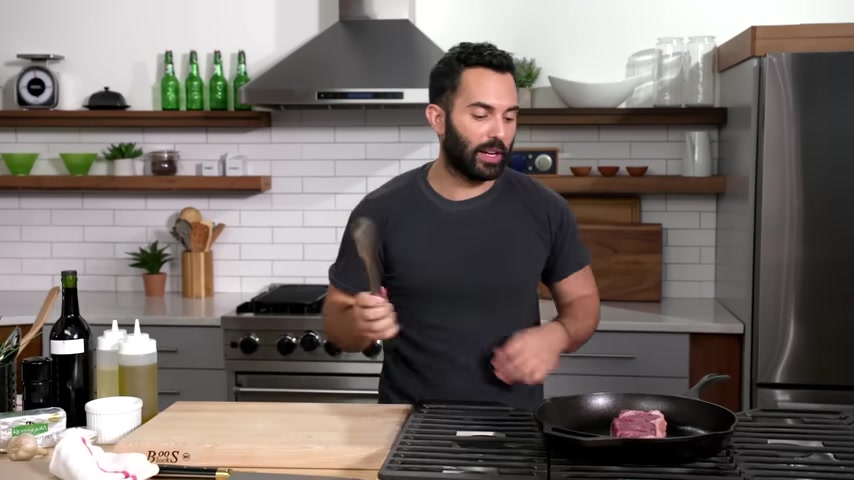
I'm just gonna put this steak away from me and I'm gonna press it down so you can use tons at this point .
You , it needs to hit a certain temperature in order for it to have the my reaction .
And that my reaction is that kind of dec caramelization of the meat hitting the pan .
That's why I go on medium high heat , high heat will tend to burn too quickly .
You'll notice that I'm just gonna be occasionally pressing on the meat so that it does have direct contact to the pan .
I could see around the edges that it's starting to brown .
What I tend to do is press on the steak occasionally and move the pan around just so that it is getting an even amount of heat .
So I try not to peak until I'm pretty sure I usually will go about 3 to 4 minutes .
Uh , on one side before I flip .
When I see a deep kind of caramelization , it's ready to flip .
So you'll see around the edges .
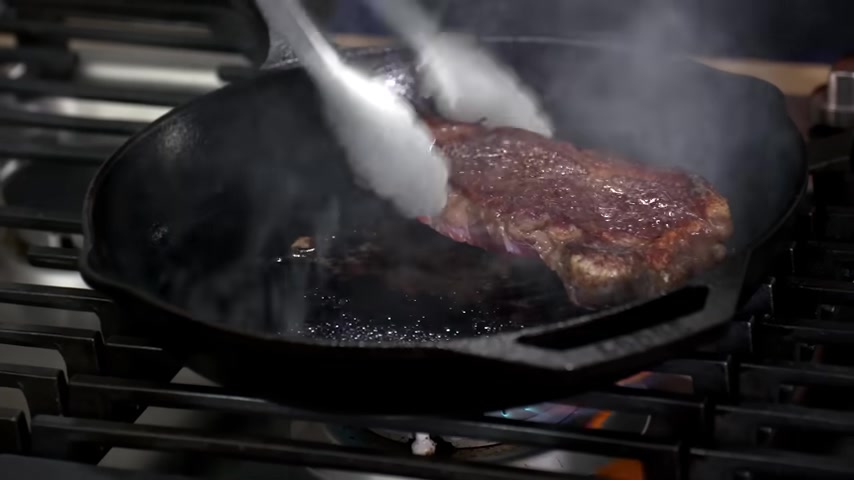
It's starting to brown this at the very bottom .
That's a good indicator .
I'm going to flip it now , I'm gonna throw some things into the pan .
I'm just adding a head of garlic and maybe a sprig of rosemary .
You could add any kind of hard or bay leaf thyme sage .
I'm gonna flip this and just start searing the edges .
That's kind of the forgotten part .
People just think to sear the kind of two sides , but you really want it to caramelize all over .
So what I'll do is about a minute per side .
You could see like compared to the grill , you're developing a fond the brown bits on the bottom and you can drain the fat out after the steak is done and make a pan sauce .
I'm gonna add my aromatics , my garlic head .
Let that sizzle a bit , my sprig of rosemary and then probably only need about three tablespoons of butter .
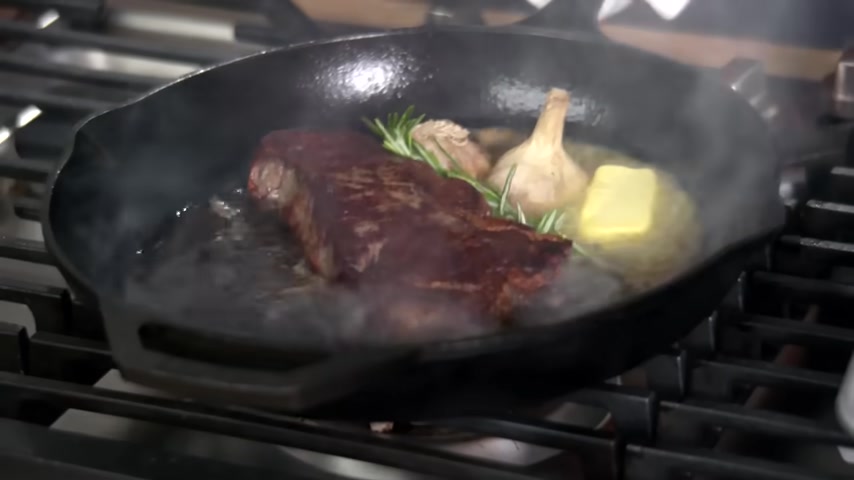
I'm gonna be using this fat to base and I want the flavor of the butter rather than the flavor of the oil .
Now , I'm gonna scoop my steak further away from me .
Let that butter melt .
You can see .
I'm just scooping up using a coon spoon , scraping up the fat that is rendered and pouring it over like that .
You're basically doing this infused almost brown butter , garlicky rosemary flavor from the steak .
I'm gonna remove the steak .
Now I'm gonna let the steak rest for at least 10 , 15 minutes .
Just so the juice is gonna redistribute if I were to slice it right now , so much of the juice is gonna release and not actually stay within the steak .
Done this indicators .
I use a thermo pen .
I'm looking for around 100 and 15 to 100 and 20 you just kind of go insert on the side of the steak and you just , it instantly gives you that 1 15 part .
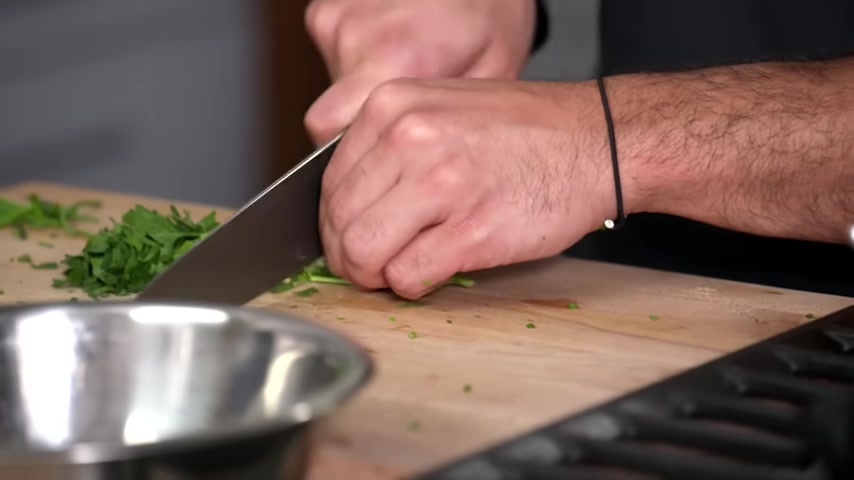
If you just want a steak , uh , that's well seasoned and that's it , then you're good .
Just let it rest and slice it up .
I kind of want a little bit more than that .
Something her and acidic to go along with the fatty steak .
This is a very , very simple sauce .
It's kind of my go to .
So I have my chives all chopped up parsley just giving it a rough chop .
I just like the kind of texture you get .
I'm also gonna get some of the stems of the parsley .
It has a more concentrated grassy flavor that I like .
Dump that .
I'm gonna add a few squirts of oil , some salt .
I'm gonna give it a splash of the sherry vinegar and then add some very coarse pepper .
Lots of pepper .
I want pepper forward .
It's only gonna get better as it sits .
I could even add everything besides the vinegar an hour and ahead and then add the vinegar towards the end .
You don't wanna add the acid too early .
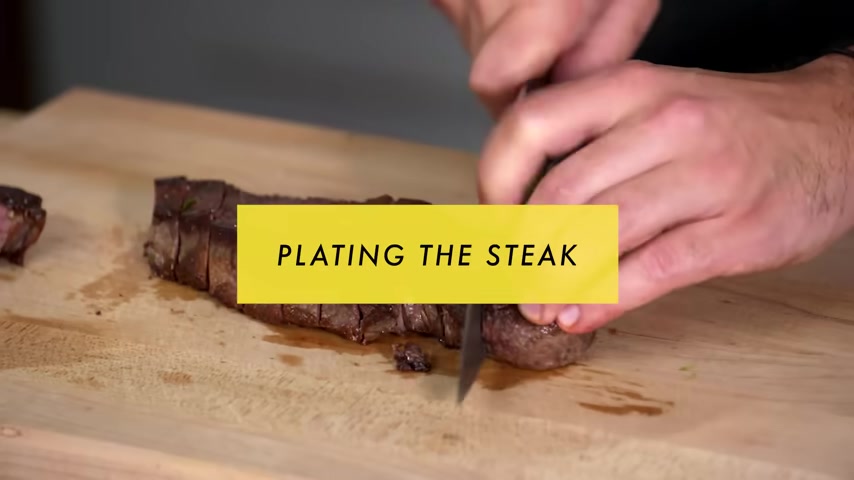
Otherwise the greens will start to darken and oxidize very bright .
Lots of texture , peppery herbie .
I don't want to press on it too much to extract the juices .
But you can see the grains , the lines of the steak , they're going across like this .
So I'm gonna be going against the grain .
If you went with the grain , you're gonna create a mouth feel that ends up becoming more chewy and less tender , right ?
So I'm just gonna start at the kind of lower end and I do this kind of little piece for myself here and then I go about half an inch and then I'm gonna season it with salt just for that added crunch and texture .
Sometimes I want a little bit more pepper .
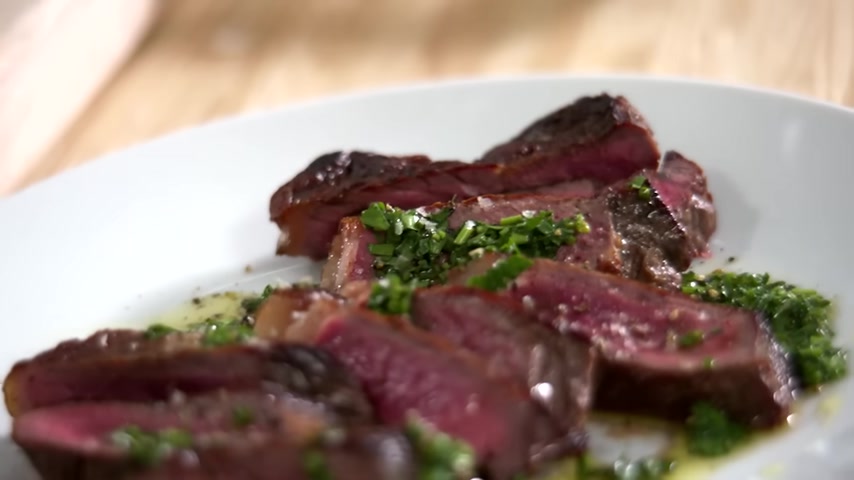
That's how you make my steak , excuse the fussy plate .
And I don't think it's fussy .
You get that medium rare , beautiful kind of center really crunchy on the surface .
A really vinegary herbie sauce to go along with it .
Lots of black pepper and Alton on the stovetop .
All happens so quickly super tender .
The fat cap is still attached , but so much of it has rendered and it's become soft .
Now , if it was seared really hard and you didn't kind of score it at all , then it would have caught it harden a little bit and become more chewy , but it's come , it's almost creamy inside , perfectly seasoned , I think even again , just because this wasn't too big of a steak season .
It , even if it's just 20 minutes ahead , does a big difference until the steak fully absorbs the salt .
And I think also a thing to remember is that you don't want your steak to be , uh , sitting at room temp for a while before it hits the hot pan .
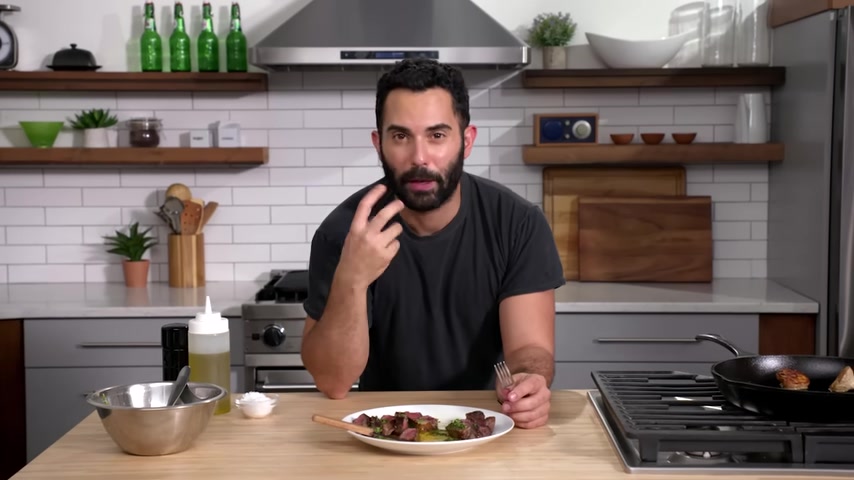
You want that really hot pan to get that sear and that crust on the outside .
But if your steak is sitting at room temp , it's gonna be kind of soft and like it's not retaining its shape , it's a little bit loose .
And so , uh , it's likely to overcook quickly .
I think I made my perfect steak .
Please .
Please don't be kind of going rogue on this .
There's not a lot of ingredients .
There's not a lot of steps .
So just try to like stick with it .
Don't be , send me photos if you're working on a non sick pack because that's not gonna work .
Please try this at home .
I promise you'll love it .
I just do that and I take , I started a fire alarm .
It's hot in here .
Are you looking for a way to reach a wider audience and get more views on your videos?
Our innovative video to text transcribing service can help you do just that.
We provide accurate transcriptions of your videos along with visual content that will help you attract new viewers and keep them engaged. Plus, our data analytics and ad campaign tools can help you monetize your content and maximize your revenue.
Let's partner up and take your video content to the next level!
Contact us today to learn more.